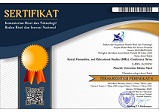CREATIVE THINKING: REVIEWED FROM INFORMATION PROCESSING MODEL (IPM) FOR PRIMARY SCHOOL TEACHERS
Abstract
Memory is a structured system and causes organisms to be able to record facts and use knowledge to guide their behavior. Memory is also said to be a tool that serves to capture, process and use it when needed. Memory takes place through three processes, namely encoding, storage, and retrieval. The brain works through the information process by processing information through sensory stimulation and storing it into memory and involving thinking activities. Increasing the potential for creative thinking, the incoming stimulus is determined by personal situational factors. The purpose of this literature study is to find out that creative thinking is the result of information processing that occurs in human memory. The results of this literature study show that situational factors that are external or attention getter and prominent characteristics such as visual movements, novelty, clarity (fluency), new and extraordinary stimuli attract attention so that they can influence positive perception that goes into short-term memory. Through thinking activities, one's ideas and concepts developed through the process of relationships between the parts of information stored in him. Thinking is done to understand reality in order to make decisions (decision making), problem-solving (problem-solving) and produce new ones (creativity).
Keywords
creative, information processing model.
Full Text:
PDFRefbacks
- There are currently no refbacks.





